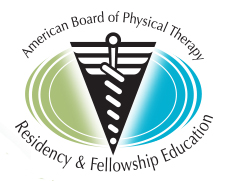POST-PROFESSIONAL EDUCATION OPPORTUNITIES
Life-long learning is a vital part of continued competence and active professional growth for physical therapists and researchers.
The formal tools to achieve this growth fall under the heading of post-professional education. Post-professional education tracks exist to further clinical skill based knowledge, develop skills to perform research, enhance teaching and educational method skills and for specific scientific and philosophical areas of development which can be used for professional growth and advancement.
Current healthcare trends demonstrate the need and expectation for practitioners to have knowledge and skills in step with advanced degrees and specialization. If you are looking for ways to advance your knowledge and practice, there are three categories of post-professional learning to consider:

The American Board of Physical Therapy Residency and Fellowship Education (ABPTRFE) is the accrediting body for the American Physical Therapy Association (APTA) for post-professional residency and fellowship programs in physical therapy.
Accreditation is the process used by APTA to ensure the quality of the education that participants receive in residency and fellowship programs in physical therapy. It is a voluntary, nongovernmental, peer-reviewed process that occurs on a regular basis. More information available at abptrfe.org.

RESIDENCIES/FELLOWSHIPS
Residency Programs
Number of Accredited Programs: 219
Number of Graduates (1999-2015): 2643
- Combines opportunities for ongoing mentoring including formal and informal feedback to the physical therapist resident
- Goal for the residency program is to have increased work in a specialized advanced practice area
- Program’s curriculum must cover the entire corresponding Descriptions of Specialty Practice
- Minimum of 150 hours of 1:1 mentoring and 75 hours of didactic instruction while treating patients in a specialized setting
See the full list of residencies available on ABPTRFE’s website.
Fellowship Programs
Number of Accredited Programs: 42
Number of Graduates (1999-2015): 1304
- Combines opportunities for ongoing mentoring to the physical therapist fellow-in-training, including required written and live patient practical examinations
- Fellowships should have a curriculum based in one or more subspecialty (specific areas of a Physical Therapy Specialty Practice) areas.
- Subspecialized programs must include postprofessional education and training in the scientific principles underlying practice applications
- Minimum of 100 hours of 1:1 mentoring and 50 hours of advanced didactic instruction within an area of subspecialty over the course of the program
See the full list of fellowships available on ABPTRFE’s website.
How Do Residencies and Fellowships differ?
A Residency is…
- Designed to advance a therapist’s expertise in a defined area of clinical practice
- Often designed to prepare individuals to become board-certified clinical specialists by the American Board of Physical Therapy Specialties
- For newer professionals, typically
A Fellowship is …
- Designed to provide greater depth within a subspecialty area (i.e., critical care, neonatology, manual therapy, upper extremity, etc.)
- Not for new professionals
- Only open to applicants demonstrating prior to application one of the following: specialist certification, completion of residency, clinical skills
TERMINAL DEGREES
Physical therapist education is available at a post-professional doctoral level with enhanced educational and research opportunities for physical therapists.
Physical Therapists can choose multiple venues for advancing knowledge past their entry level degree. It is important that each therapist determine what type of degree and university best suits him/her needs and ongoing professional development needs. Most post-professional degree areas require a course work and an original research component. Post-professional degree areas include:
- PhD – Doctor of Philosophy
- EdD – Doctor of Education
- DSc – Doctor of Science
- DHS – Doctor of Health Science
For a full listing of available programs, please visit the APTA website.
CLINICAL SPECIALIZATION
ABPTS – American Board of Physical Therapy Specialists
- Voluntary process
- Recognize physical therapists with advanced clinical knowledge, experience, and skills in a specialized area of practice
- Assist consumers and healthcare community in identifying PTs who are specialists
Requirements for Application
- Applicant must demonstrate 2,000 hours of direct patient care in the clinical specialty area
- Evidence of successful completion of an APTA approved post-professional residency program
- Some specialty areas require:
- Emergency Care- Sports
- ACLS Certification, Data Analysis Project- Cardiovascular and Pulmonary
- Patient Reports- Clinical Electrophysiologic
- Case Reflections- Woman’s Health
- Exam is 200 questions in length and applicants are given six hours to complete exam
- Exam covers all aspects of the chosen area of specialization
EXISTING SPECIALISTS
| Illinois Specialists by Specialty Area | Number (as of June 2016) |
| Cardiovascular & Pulmonary | 16 |
| Clinical Electrophysiology | 3 |
| Geriatrics | 68 |
| Neurology | 113 |
| Orthopedics | 479 |
| Pediatrics | 77 |
| Sports | 44 |
| Women’s Health | 21 |
For a current directory of specialists, please visit the ABPTS website.
